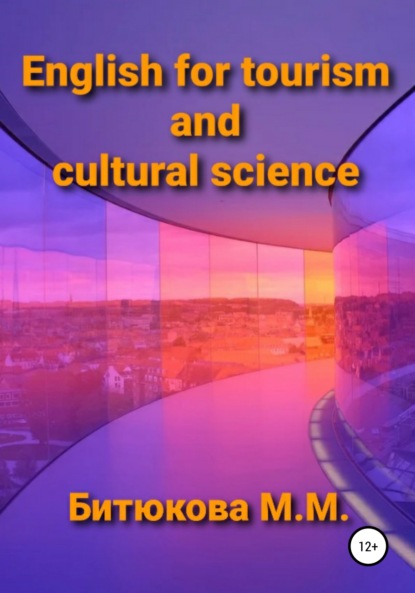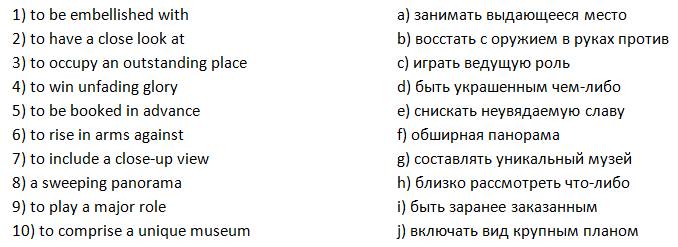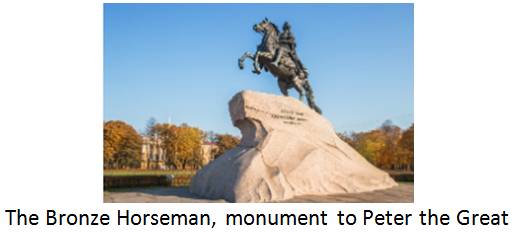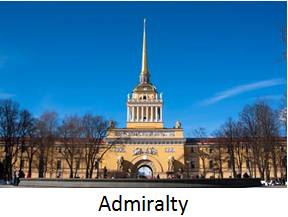
Полная версия:
English for tourism and cultural science
29. To win unfading glory for – снискать (завоевать) неувядаемую славу для
Tasks on the text
1. Make up special questions concerning the information about Moscow based on the text.
2. What do these numbers and dates refer to according to the text?

3. True or False? If the statement is false correct it.
1) 1137 is considered the year of Moscow foundation.
2) Moscow became the capital of the state twice: in the 15th and in the 18th centuries.
3) The first very important defeat of Hitler’s army was in Moscow.
4) You can get acquainted with the variety of Moscow streets during the General Sightseeing Tour of the city of Moscow.
5) You can see some of the city’s architectural sights from the river during the tour of Moscow’s Architecture.
6) Most of the buildings of the Dosnkoy Monastery are in the Moscow Baroque style.
7) There are a lot of splendid estate-museums in Moscow: Tsaritsyno, Kuskovo, Archangelskoye, Yasnaya Polyana and many others.
8) In the Boshoi theatre you can enjoy to the utmost opera and ballet productions famous all over the world.
Discussion
Choose one or two of the following questions and discuss them in pairs. Then share your ideas with the whole group.
1) Do you like going sightseeing in our capital city? What is your favourite place? Why do you like it?
2) Is it possible to visit all Moscow museums in a day or two? Why/Why not?
3) Have you ever been on any excursion in Moscow? What were your impressions? Would you recommend them to our foreign guests?
4) Do you like going to the theatres? When did you last go there? What theatre were you in? What did you see?
5) What fact from the history of Moscow do you consider the most interesting or amazing? Why does it impress you?
Tasks on Vocabulary
1. Fill in the gaps with a suitable word from the box.

1) The palaces and cathedrals of the Kremlin contain … of old art.
2) Moscow is situated at the … of trade routes in the heart of the Russian lands.
3) The city … the unity of many large and small nations and nationalities of the country.
4) From Vorobyovy Hills you can enjoy a … panorama of Moscow.
5) St. Basil’s Cathedral is a unique exquisitely … monument of the 16th century.
6) This oldest district … a whole collection of architectural monuments of the 16th-19th centuries.
7) This person used to be an … figure in Russian cultural and political life.
8) This museum has a fabulous collection of Russian porcelain, antique …, pottery and glass.
2. Match English words and combinations with the Russian equivalents.

3. Translate the following sentences into English using the words and combinations from Vocabulary.
1) Они были взволнованы великолепной панорамой города, которая открывалась со смотровой площадки (viewing point) в самом центре.
2) В этом музее можно найти информацию об одной из выдающихся персон в культурной жизни нашей страны.
3) Усадьба расположена в живописном окружении, рядом с прудом, в 16 км от города.
4) Фонтан на центральной площади города символизирует единство нескольких наций, которые когда-то входили в состав нашего государства.
5) Тур по памятным местам дает посетителям возможность увидеть самые незабываемые места города.
6) В прошлом месяце в музее изобразительных искусств выставляли напоказ редчайшие картины художников-импрессионистов и нам дали возможность увидеть эти прекрасные полотна.
7) Эта сокровищница древнерусской культуры и искусства была упомянута в летописях, которые хранятся в Историческом музее Москвы.
8) Во время экскурсии по городу мы познакомились с памятниками архитектуры и предложили друзьям посетить несколько музеев на их выбор.
Creative Tasks
Look at the information about the Richards family below and prepare an itinerary for a weekend break in Moscow for the whole family.
Mr. and Mrs. Richards and their two boys aged 13 and 15 are planning to spend a weekend in Moscow. They will arrive at the airport on Friday evening at 20.30 and leave at 21.45 on Sunday.
Mr. Richards is interested in the 16th century history and painting. He prefers bus trips, but will tolerate walking on foot.
Mrs. Richards enjoys river trips and theatre performances and she is very fond of religion.
The boys find art and culture very boring. Their main interests are boats and sport. They enjoy walking on foot and breathing fresh air, especially in the evening.


Unit 2. Russia. Saint Petersburg
Historical Review

Saint Petersburg is a city and a federal subject of Russia located on the Neva River at the head of the Gulf of Finland on the Baltic Sea. The city’s other names were Petrograd (1914–1924) and Leningrad (1924–1991). It is often called just Peterburg and is informally known as Piter.
It was founded by Tsar Peter I of Russia on May 27, 1703. Unlike some cities, it was not created by a process of gradual graceful development but was forcibly constructed, stone by stone, under the force and direction of Peter the Great, for whose patron saint the city is named. World-class architects participated in the building of the city and today it remains an imperial city of golden spires and gilded domes, of pastel palaces and candlelit cathedrals. St. Petersburg is a fascinating place which dazzles the eye of a visitor with numerous architectural landmarks, museums, palaces, parks, wide avenues, spectacular bridges and stylish monuments. Born in the heart of an emperor, St. Petersburg is Russia’s adopted child. So unlike the Russian cities that came before it, St. Petersburg – with its strict geometric lines and perfectly-planned architecture – is almost too European to be Russian. And yet it is too Russian to be European.
The history of the city is closely connected with uprisings, assassinations of Tsars, power takeovers and several revolutions that influenced not only Russia but the whole world.
The Revolution of 1905 initiated here and spread rapidly into the provinces.
During World War I, the name St. Petersburg was seen to be too German, so the city was renamed into Petrograd. In 1917 the February Revolution, which put an end to the Russian monarchy, and the October Revolution, which ultimately brought Vladimir Lenin to power, broke out in Petrograd. The city's proximity to the border and anti-Soviet armies forced the Bolsheviks under Lenin to transfer the capital to Moscow on March 5, 1918. In general St. Petersburg was the capital of the Russian Empire for more than two hundred years (1713–1728, 1732–1918).
After Lenin’s death the city was renamed into Leningrad.
For decades Leningrad was glorified by the Soviet propaganda as "the cradle of the revolution" and "the city of three revolutions", many spots related to Lenin and the revolutions, such as the cruiser Aurora, were carefully preserved. Many streets and other toponyms were renamed accordingly.
During World War II, Leningrad was besieged by Nazi Germany and co-belligerent Finland. The siege lasted 872 days from September 1941 to January 1944. The Siege of Leningrad was one of the longest, most destructive and most lethal sieges of major cities in modern history. It isolated the city from most supplies except those provided through the Road of Life across Lake Ladoga, and more than a million civilians died, mainly from starvation. Many others were eventually evacuated or escaped by themselves, so the city became largely depopulated. For the heroic resistance of the city and tenacity of the survivors of the Siege, in 1945 Leningrad became the first city in the Soviet Union awarded the title Hero City.
Now St. Petersburg is Russia’s second largest and Europe’s fourth largest city (by city limit) after Moscow, London and Paris. The city has 5.4 million inhabitants, and over 6 million people live in its vicinity.
St. Petersburg is situated on 44 islands in the Neva River’s delta and is famous for its embankments, museums and, of course, for its magical summer White Nights, which begin at the start of June and last to the middle of July.
Among cities of the world with over one million people, St. Petersburg is the northernmost. The Historic Centre of Saint Petersburg and Related Groups of Monuments constitute a UNESCO World Heritage Site. It is a major European cultural center, an important Russian port on the Baltic Sea, it has been Russia’s political and cultural centre for 200 years. And sometimes it is referred to as the northern capital of Russia.
Excursions
Sightseeing tour (by bus, with a guide/interpreter; duration – about 4 hours). You will see Nevsky Prospect, Admiralty, the cradle of the city – Peter and Paul’s Fortress, St. Isaac’s Cathedral, legendary cruiser Aurora, Bronze Horseman, Spilled Blood Cathedral and others.
The City Tour comments with a drive along Nevsky Prospect towards Palace Square and the Winter Palace. From Vasilyevsky Island you may enjoy outstanding architectural features such as Peter and Paul Fortress and the five buildings of the Hermitage.
The tour continues onto the main building of St. Petersburg University, the imposing St. Isaac’s Cathedral, the monument to Peter the First, known as the Bronze Horseman, and Mariinsky Palace. Other famous sights include Nikolsky Cathedral, which is an active Russian Orthodox Church.
Then you will see Rastrelli Square, Smolny Cathedral and Smolny Institute, where you will be told about events of the Revolution of 1917.
After a drive along Nevsky Prospect you return to Arts Square with its beautiful buildings, housing the Mussorgsky Opera and the Ballet theatre and the Russian Museum.

City tour + Peter and Paul’s Fortress (by bus, with a guide/interpreter; duration – 4 hours).
The tour will take you throughout the historical center of St. Petersburg and includes spectacular views of the Neva river, Griboyedov canal, Moika canal, many bridges connecting the city islands, the Old Holland area of the city and trips to 2 main islands of Petrogradsky and Vasilyevsky.
The tour will introduce you to Nevsky Prospect – the city’s famous boulevard, the Winter Palace, other palaces and churches and to the areas of the city formerly inhabited by Dostoyevsky, Rasputin and numerous Russian princes and counts.
You will then visit Peter and Paul’s Fortress.
The fortress was founded by Peter the Great in 1703. Besides the ancient fortifications, the fortress includes the Peter and Paul’s Cathedral, built in the early 18th century. The bell-tower makes Peter and Paul’s Cathedral the tallest building in St. Petersburg (122.5 meters or 404 feet 3 inches high).
The cathedral includes the burial vault of Peter the Great and other Russian Tsars, the museum of Trubetskoy Bastion prison and the expositions: the History of St. Petersburg, History of the Imperial Mint as well as a printing workshop and the museum of space exploration and missilery. It is also possible to walk along the walls of the fortress and observe the fabulous architecture of the surrounding areas.
Today the fortress is one of St. Petersburg’s major tourist attractions and has become the emblem of the city.
Open: Thursday-Monday from 11.00 am to 5.00 pm, Tuesday to 4.00 pm.
Church Tour (by bus, with a guide/interpreter; duration – 3 hours).
During this tour you will get acquainted with the most famous cathedrals and churches of the city starting with St Isaac's Cathedral.
It was originally the city's main church and the largest cathedral in Russia.
It was built between 1818 and 1858, by the French-born architect Auguste Montferrand, and became one of the most impressive landmarks of the Russian Imperial capital. One hundred and eighty years later the gilded dome of St. Isaac's still dominates the skyline of St. Petersburg.
The cathedral's facades are decorated with sculptures and massive granite columns (made of single pieces of red granite), while the interior is adorned with incredibly detailed mosaic icons, paintings and columns made of malachite and lapis lazuli.
Open: Thursday-Monday from 11.00 am to 5.00 pm.
The next stop will be at the Church of the Savior on the Spilled Blood (or just the Church on the Blood).
This marvelous Russian-style church was built on the spot where Emperor Alexander II was assassinated on March 1, 1881. Constructed between 1883 and 1907, the church was designed in the spirit of the 16th and 17th century Russian architecture, inspired particularly by St Basil's Cathedral on Red Square in Moscow.
The interior of the church, a memorial to the late Emperor Alexander II, was decorated with different shades of marble and several thousand square yards of mosaic.
This has to be one of the city's most beautiful sights and a great spot for taking pictures.
Open: Friday-Tuesday from 11.00 am to 6.00 pm.
Dostoevsky tour (by bus, with a guide/interpreter; duration – 4 hours).
Dostoevsky Walk. You will see ‘the other side’ of St. Petersburg – old slum areas around the Hay Market, a maze of small lanes and courtyards, straight out of the writer’s novels. Sites from “Crime and Punishment”.
Dostoevsky Museum. Arranged according to the original interior design of the great writer’s last apartment. On display there are documents, photographs and personal belongings of the writer. The exhibition outlines Dostoevsky’s life and work.
Open: daily except Mondays and last Wednesday of every month, from 11.00 am to 5.00 pm.
The Neva and the Bridges (by boat; duration – 1,5 hours)
Nevsky is crossed by three canals which are an integral part of St. Petersburg's beauty. There are a great number of rivers and canals in the city – it is a city "on water". That is why it is often referred to as "the Northern Venice" or "the Northern Amsterdam". There is no pleasure like taking a wonderful boat trip along the rivers and canals of the "bridge city".
Oh, the bridges! They will take your breath away. There are about 342 bridges in the city, and among the most beautiful ones are the Palace Bridge, the Trinity Bridge, the Foundry Bridge and the Bridge of Peter the Great across the Neva river, and the Anichkov Bridge across one of the canals – the Fontanka river. It is situated right in the Nevsky Prospect and is considered to be the most romantic place in St. Petersburg! The Anichkov Bridge is so famous and loved by all for its four beautiful sculptures of men and horses! They are so expressive and dynamic that you would think they are alive! And each of the sculptures is different!
Shipping season is from April 19 to September 30; bridges open from May to late October according to a special schedule.
Museums (in the city)
The Hermitage Museum (on foot, duration – 3 hours).
The Hermitage Museum is Russia’s best gallery of world art, one of the most prominent art museums in the world and definitely the main tourist attraction of St. Petersburg.
The museum was founded in 1764 when Catherine the Great purchased a collection of 255 paintings from the German city of Berlin. Today, the Hermitage boasts over 2.7 million exhibits and displays a diverse range of art and artifacts from all over the world and from throughout history (from Ancient Egypt to the early 20th century Europe).
The Hermitage’s collections include works by Leonardo da Vinci, Michelangelo, Raphael and Titian, a unique collection of Rembrandt and Rubens, many French Impressionist works by Renoir, Cezanne, Manet, Monet and Pissarro, numerous canvasses by Van Gogh, Matisse, Gauguin and several sculptures by Rodin. The collection is both enormous and diverse and is an essential stop for all those interested in art and history.
The experts say that if you were to spend a minute looking at each exhibit on display in the Hermitage, you would need 11 years before you’d seen them all.
Open: Tuesday-Sunday from 10.30 am to 5.00 pm.

Russian Museum
The State Russian Museum is the world’s largest museum of Russian art. It is located in the very center of St Petersburg, just of the city’s central magisterial, Nevsky Prospect. The museum is housed in the former Mikhailovsky Palace, a stunning monument of Empire architecture.
The collection of the Russian Museum numbers some 400,000 works and covers the entire history of Russian fine art from the 10th century to the present day. It reflects virtually every form and genre of art in Russia, including a unique collection of Old Russian icons, works of painting, graphic art and sculpture, decorative and applied art, folk art and numismatics, as well as the world's finest collection of Russian avaunt-garde.
If you walk from the main building up to Nevsky Prospect and then turn to the right, you can see the plastic front of the oldest Stroganov Palace, named after its owners, the Stroganov family.
Then you can have a wonderful trip upon embankment of the Moika river. When you come to Mars Square, you can see to the left the Marble Palace, built in the late Neoclassicism style. And to the right you can see the romantic silhouette of St. Michael's (Engineers) Castle.
Open: Wednesday – Monday from 10.00 am to 5.00 pm.
Kazan Cathedral
The cathedral is named after the miracle-working icon of Our Lady of Kazan – the protectress of the Imperial House of Romanov – which was kept here. The cathedral was put up in 1811 by architect Andrey Voronikhin on Nevsky Prospect – the main street of the city.
It was conceived as a replica of St. Peter's Cathedral in Rome. It has the colonnade that is similar to that of Bernini. But there are certain differences between the two constructions and Kazan Cathedral has its own inimitable charm and brilliance. In 1811-1858, Kazan Cathedral was the main cathedral of the city. In front of it there are two monuments to the field marshals who defeated Napoleon in fearless battles – Kutuzov and Barklay de Tolly. Mikhail Kutuzov is buried inside the cathedral.
After 1932, when the cathedral was closed, the building housed the Museum of the history of Religion and Atheism. In 1991, services have been resumed. Now it is an acting Orthodox church.
Open: daily.
Kunstkammer
It is the oldest state museum in Russia. It was founded in 1704 as the library and collections of "monsters and rarities" gathered by Peter I.
In 1992, the Kunstkammer became an independent museum and research institute within the Department of History of the Russian Academy of Sciences. The museum has kept its original title – "Kunstkammer" (translating from German – "chambers of curiosities") – and has the name of Peter the Great given to it in 1903. Today its complete name is: Peter the Great's Museum of Anthropology and Ethnography (Kunstkammer) of the Russian Academy of Sciences.
Open: Tuesday-Sunday from 11.00 am to 4.30 pm. (except last Tuesday of each month).
Cruiser Aurora
The cruiser Aurora was built in 1897-1900 by the "New Admiralty" in St. Petersburg and joined Russia's Baltic fleet in 1903. The ship is 126.8 meters (418 feet 5 inches) long, 16.8 meters (55 feet 5 inches) wide and weighs 7600 tons. With the speed of 20 knots (23.3 miles per hour) it can travel independently for up to 1440 nautical miles.
As the training ship of the Baltic fleet, on the night of October 25-26, 1917, the Aurora fired a blank shot at the Winter Palace (then the residence of the Provisional Government), giving the signal to the rebellious workers, soldiers and sailors to storm the palace. That moment changed Russia's history for over 70 years.
In 1952 the cruiser was turned into the Ship Museum, which became the branch of the Central Naval Museum. In 1992 Saint Andrew Naval Flag raised over the Cruiser Aurora.
The Aurora exposition features over 500 original documents, photographs, and ship objects concerning the cruiser's history and its participation in Russian history. For those who wish there are thematic excursions of the underwater cruiser part and machine-boiler sector.
Open: Tuesday-Thursday, Saturday-Sunday from 10.30 am to 4.00 pm.
Museums (in the countryside)
Peterhof, modern name is Petrodvorets (by bus, with a guide/interpreter; duration – 6 hours).
The Grand Palace of Peterhof stands on the hill. Two parks which surround it received the names Upper & Lower ones. The most famous part of this ensemble is Lower Park. With its 173 fountains it makes a strong competition to French Versailles.
On the territory of Lower Park you can find three monumental fountains, one of them comprising the famous Samson – "Samson, tearing apart the jaws of the lion". The whole composition of the fountain complex is devoted to the victory over Sweden. Samson symbolizes Russia defeating Sweden – the lion. The Great Cascade is decorated with gilded statues of ancient Greek and Roman gods and heroes, which all are allegories of different events of the Northern War.
Since the time of Peter the Great remained the so-called joke-fountains – a fun for kids and adults. For example, a calm park bench. Once you sit on it, the jets of water pour over you! There are 5 types of joke-fountains, all different and unique.
Fountains start to work on the last weekend of May and are closed around the middle of September. The exact dates are different from year to year.
There are 8 museums on the territory of the park.
Open: daily except Mondays and last Tuesday of each month, from 10.00 am to 5.00 pm.
Lower Park (fountains) is open daily, from 10.00 am to 6.00 pm.
Gatchina (by bus – with a guide/interpreter; duration – 6 hours).The palace and park complex of Gatchina, a town located 45 km south-west of St. Petersburg, is an outstanding example of eighteenth-century landscape architecture. The palace for Catherine II’s favorite, Count Orlov, built in the Early Classical Style upon the project of Antonio Rinaldi between 1766 and 1781, was enlarged by Vincenzo Brenna in 1796 – 1798, and reconstructed by Roman Kuzmin between 1845 and 1860. It had about 600 rooms, a theatre, and many works of art, and was also surrounded by a fine park. Upon Orlov’s disgrace the palace passed to Catherine's son, Paul I, who transformed it into a combination of palace, fortress, and barracks. Although badly damaged during World War II, the palace was restored and is now a museum. The modern city is a railway junction, with machine building, metalworking, and light industries.
Gatchina Palace is opened: 10.00 am – 5.00 pm.
Closed: Monday and last Tuesday of each month.
Tsarskoye Selo (Pushkin) (by bus – with a guide/interpreter; duration – 6 hours).
Tsarskoye Selo (formerly known as Pushkin) is one of St. Petersburg's numerous Imperial estates. Located just 25 kilometers south of the city, the estate boasts a large landscape park, dotted with architectural follies, and centered on the magnificent blue, white and gold Catherine Palace. Named after its creator, Empress Catherine, the second wife of Peter the Great.
Catherine Palace houses some beautiful Baroque interiors, including the luxurious Grand Hall, a long, gold, mirrored ballroom. The Palace also boasts a unique Amber Room, whose priceless amber panels were stolen by Nazi troops during World War II, but which are now being painstakingly recreated by Russian craftsmen.



